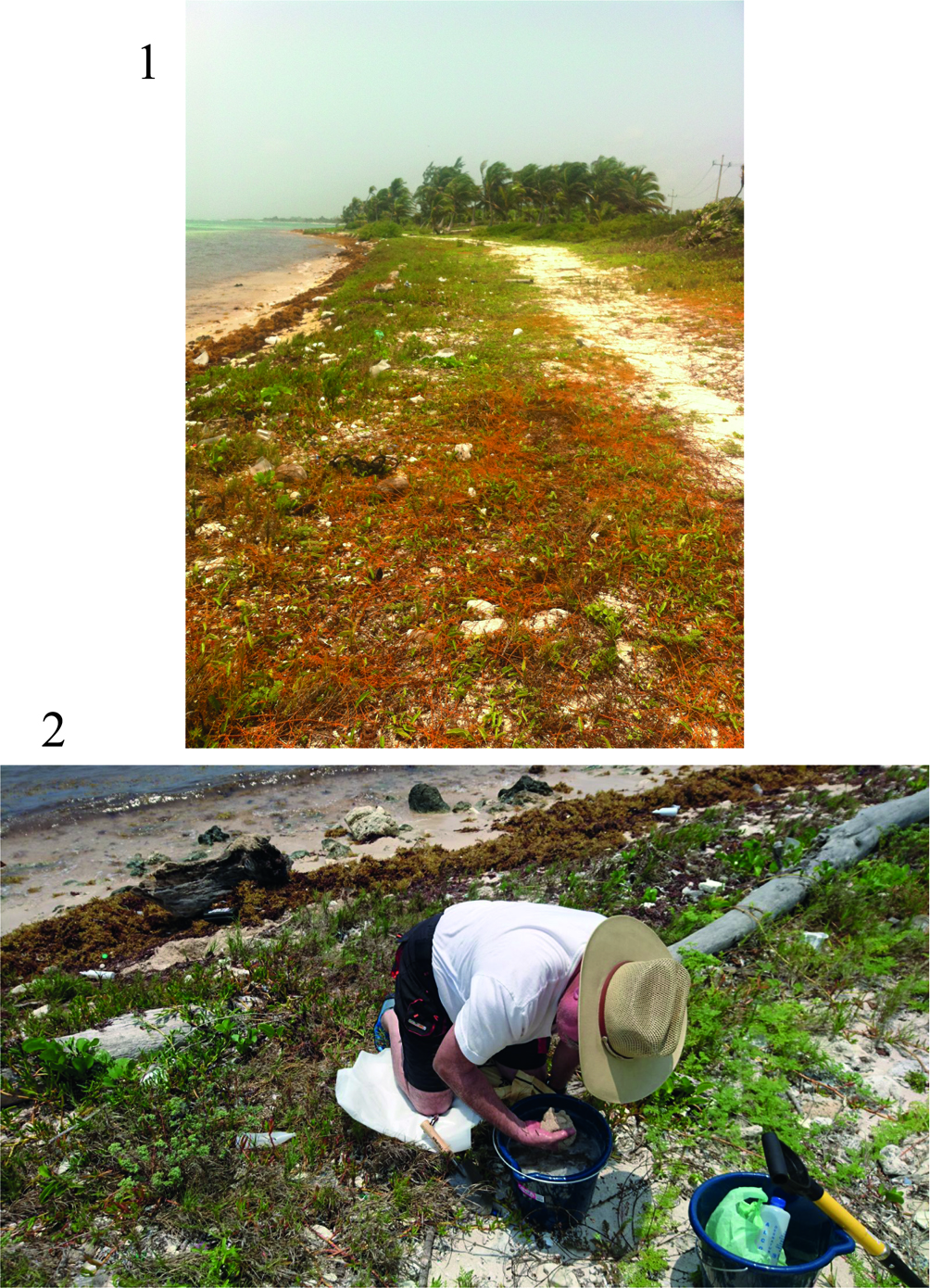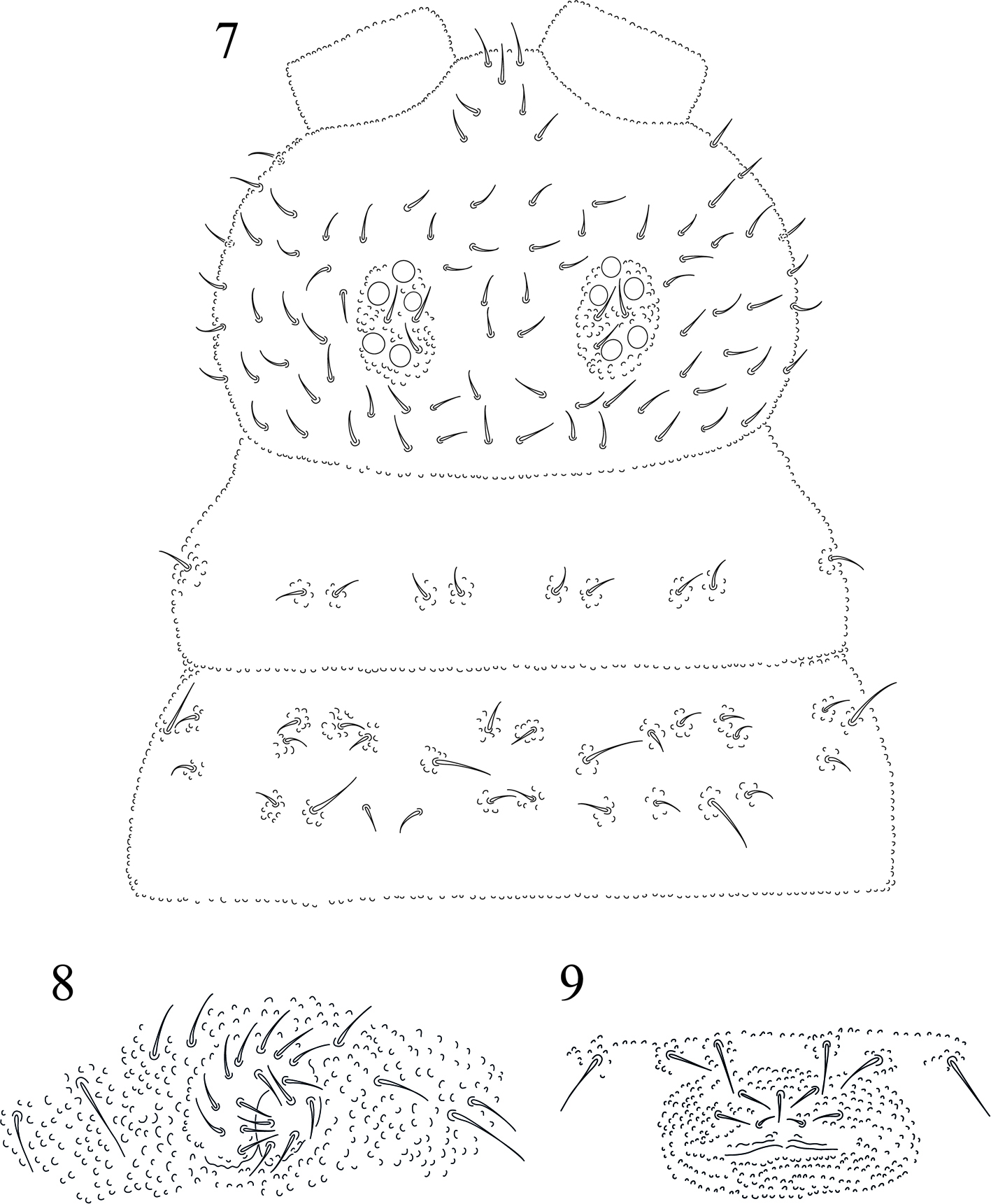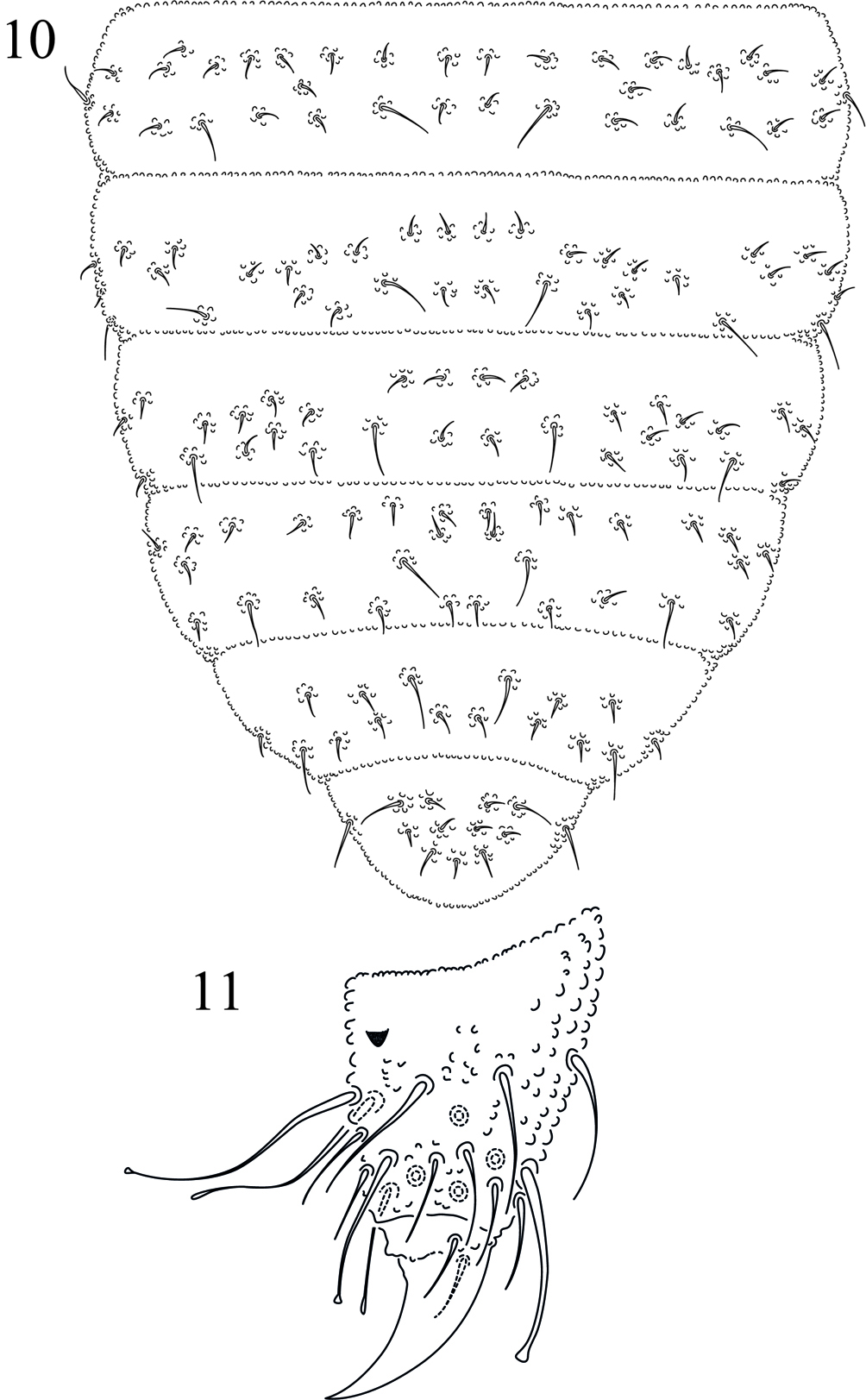A new Mexican species of Paraxenylla (Collembola: Hypogastruridae) from marine littoral sand of Quintana Roo, Mexico
José G. Palacios-Vargas a, *, Magdalena Vázquez b
a Laboratorio de Ecología y Sistemática de Microartrópodos, Departamento de Ecología y Recursos Naturales, Facultad de Ciencias, Universidad Nacional Autónoma de México, Circuito Exterior s/n, Ciudad Universitaria, 04510 Ciudad de México, Mexico
b División de Ciencias e Ingenierías, Universidad de Quintana Roo, Boulevard Bahía s/n Esq. Ignacio Comonfort, Col. Del Bosque, 77019 Chetumal, Quintana Roo, Mexico
*Corresponding author: troglolaphysa@hotmail.com (J.G. Palacios)
Abstract
The new species Paraxenylla mahahualana sp. nov. from Quintana Roo is described, it is similar to P. cubana, and shares the presence of ventral tube with 1 + 1 seta but differs in having tibiotarsi with 5 tenent hairs and 5 cylindrical sensilla on antennal segment IV and 3 + 3 tenacular teeth. A key for the 10 species known in the genus is also given.
Keywords:
Arenicolous; Springtail; Taxonomy, Mexican Caribbean
© 2018 Universidad Nacional Autónoma de México, Instituto de Biología. Este es un artículo Open Access bajo la licencia CC BY-NC-ND
Una especie nueva mexicana de Paraxenylla (Collembola: Hypogastruridae) de arena del litoral marino de Quintana Roo, México
Abstract
Se describe la nueva especie Paraxenylla mahahualana sp. nov. de Quintana Roo, que es similar a P. cubana, con la que comparte la presencia de un tubo ventral con 1 + 1 sedas, pero difiere en que los tibiotarsos tienen 5 sedas capitadas y las 5 sensilas del artejo antenal IV son cilíndricas y 3 + 3 dientes tenaculares. Se proporciona una clave para las 10 especies conocidas en el género.
© 2018 Universidad Nacional Autónoma de México, Instituto de Biología. This is an open access article under the CC BY-NC-ND license
Palabras clave:
Arenícola; Cola de resorte; Taxonomía, Caribe mexicano
Introduction
Collembola are mainly hygrophilous arthropods and may be found on land or directly associated to water habitats. Following Deharveng et al. (2008), 525 water-dependent species of springtails have been reported worldwide, of which 465 are found in freshwater habitats and close to 60 from marine littoral environments. The same authors believe that for the Neotropical region approximately 45 water-dependent species have been recorded. In Mexico, 39 taxa have been recorded associated to aquatic environments, 16 from freshwater surfaces and the benthic zone of deep lakes (Palacios-Vargas, 2000; Palacios-Vargas et al., 2018), and 23 living in marine littoral biotopes associated to sand, rocky surfaces and crevices at marine coastal areas (Palacios-Vargas, 2000). If those living in humid caves are taken into account the total might be close to one hundred species (including the unpublished records of the Project LE002 CONABIO, Facultad de Ciencias, UNAM).
The genus Paraxenylla is related to marine littoral environments and only 10 species have been described so far, and even these species occur in different continents. On the most recent revision of the genus, Palacios-Vargas and Janssens (2006) described 2 species and gave new combinations for 3 of them. Queiroz and Deharveng (2008) described a new species from Brazil found in litter of the Atlantic Forest of southeast Brazil, 40 km away from the coast line. Until now, from Mexico, only P. lapazana Palacios-Vargas and Vázquez (1989) was known, and it was described from rocks on the beach of La Paz, Baja California Sur, in the Mexican Pacific Coast. Here, we describe a new species from Quintana Roo, in the Caribbean Sea of Mexico, from sand and rocks on the beach.
The genus seems to have a cosmopolitan distribution, mainly on the shores, littoral rocks, sand and several biotopes in the mangroves, and they have been found on green algae (Gama & Deharveng, 1984). Its members feed on algae and on diatoms; they may play an important role in recycling nutrients, and making them available to other consumers in the intertidal and supratidal food web.
Materials and methods
Specimens were collected on littoral beaches north of Mahahual, Quintana Roo State (Fig. 1), washing sand and rocks in buckets in several points (Fig. 2). Floating debris was examined, and specimens were captured with a fine brush and put in small jars filled with 95% ethanol. Some of them also were captured using epineustic traps (Palacios-Vargas, 1990). Collembola were sorted, cleared up and mounted under slides in Hoyer’s solution. More abundant specimens in the samples belong to Friesea josei Palacios-Vargas (Collembola: Neanuridae) described from Tamarindo Beach, Guanica, Puerto Rico (Palacios-Vargas, 1986) using the same methodology. Drawings were done using a Carl Zeiss Axiostar Plus phase contrast microscope with an adapted drawing tube. Measurements were done with an ocular micrometer. All measurements are given in micrometers.
Abbreviations used in this contribution are: Ant. = antennal segment; Abd. = abdominal segment; PAO = postantennal organ; sgd = dorsal guard sensillum; sgv = ventral guard sensillum; Th.= thoraxic segment.
Description
Paraxenylla Murphy, 1965
Syn. Haloxenylla Gama and Deharveng, 1984:131

Diagnosis
Habitus of Xenylla. Body length 360-1,500 μm, with dark blue pigment, PAO absent, with 5 + 5 eyes. Mouthparts modified with tendency to a type for chewing. Labral setae 7/ 5, 5, 4. Antennae Xenylla type, but with sensorial organ of antennal segment III with 5 similar elements, ventral guard setae between the sensorial rods. Antennal segment IV with 4 thick sensilla, one microsensillum, one subapical organ and a simple apical bulb. Tenent hairs, when present, capitate or acuminate. Unguis without empodium, with or without a median tooth. Furcula well developed, mucro completely or partially separate from dens. Tenaculum with 2, 3 or 4 teeth on each ramus. Anus terminal and abdominal segment VI as a truncate cone. Anal spines absent. Chaetotaxy of type I, with mesosetae and macrosetae. Dorsally on thoracic segments II and III with m2 (absent in Xenylla) as a macroseta. On abdominal segments I-IV, p2 is a macroseta; on abdominal V a1 is a macroseta and ss at p4. Ventral chaetotaxy of the head and abdominal segments I-III reduced. Ventral tube with 1, 2, 3 or 4 setae per side.

Type species: Xenylla (Paraxenylla) mangle Murphy, 1965
Paraxenylla mahahualana sp. nov. (Figs. 3-11)
Body length (n = 6) 780 μm (range 700-1,150 μm). Males are the smallest and females the longest, even morew than 1,100 μm. Body with short acuminate setae (5 μm). Macrosetae and sensorial setae (8-10 μm) about twice the length of ordinary setae. Color very dark blue in alcohol, black when alive, eye patches black. Ratio head: antenna = 1:0.6. Ant. I with 7 dorsal setae. Ant. II with 11 setae. Ant. III sensory organ consists of 2 very small sensory rods, 2 longer guard setae and one external microsensillum (Fig. 3). Ant. IV with 4 cylindrical sensorial sensilla, subequal in size, one microsensillum, one subapical organ and a simple apical bulb. There are also 18 long dorsal acuminate setae and 7 small thicker curving setae with apex truncate similar to sensilla (Fig. 3). Labrum with /5, 5, 4 setae. 5 + 5 eyes well pigmented.

Mandible with 5 small apical teeth (Fig. 4). Maxillae with 6 hypertrophied fringed lamellae as illustrated for P. affiniformis by Gama and Deharveng (1986). Labium with a small internal process. Only one poslabial seta. Prothorax with 4 + 4 dorsal setae (plus 1 lateral on each side). Dorsal chaetotaxy of head and thorax in Fig. 7. Trochanters with 5 setae each, femora I, II, III with 11, 11, 10 setae respectively. Tibiotarsi I, II, III with 18, 18, 17 setae respectively, each with 5 tenent hairs well developed, dorsal one more clearly capitate, 2 ventro-distal and 2 ventro-proximal less capitate (Fig. 11). On each femur, 1 long ventral acuminate tenent hair. Unguis about 10 μm long, without teeth, no empodial appendix.
Dorsal chaetotaxy of abdomen in Fig. 10. Ventral tube with 1 + 1 setae. Abd. II with 2 + 2 ventral setae, Abd. III with 4 + 4 setae. Tenaculum with 3 teeth on each ramus (Fig. 6). Mucrodens (20 μm) with only one seta, elongated with a sharp ending (Fig. 5). Female with 3 + 3 pregenital setae, 5-6 circumgenital and 2 eugenital (Fig. 9). Male with 3 + 3 pregenital setae, 10 circumgenital and 4 + 4 eugenital (Fig. 8). Each anal valve with 11 setae. Anus terminal, no anal spines.
Taxonomic summary
Derivatio nominis: from the type locality: Mahahual, Quintana Roo (Figs. 1, 2).
Type locality: Mexico: Quintana Roo: Mahuahual: Punta Chacoy. 18°95’12” N, 87°61’81” W.
Type material: holotype female on slide number 22314, 3 paratypes females and 2 males on slides numbers 22315-22320. Holotype, 2 paratype females and 1 male deposited at Colección de Ácaros y Colémbolos, Facultad de Ciencias, others in the junior author’s collection. April 30, 2017, F. Luna and J. G. Palacios-Vargas col.

Remarks
Paraxenylla mahahualana sp. nov. shares with P. cubana the presence of ventral tube with 1 + 1 seta, but they differ in the shape of Ant. IV sensilla, globular in P. cubana and cylindrical in the new species. They also differ in the number of tenacular teeth, 3 + 3 in P. mahahualana sp. nov. versus 2 + 2 in P. cubana. The tibiotarsus of the new species has 5 tenent hairs while P. cubana lacks of tenent hairs.
Key for identification of the species of Paraxenylla * (modified and completed from Palacios-Vargas & Janssens, 2006).
1. Ventral tube with 1 + 1 setae 4
1’. Ventral tube with more than 1 + 1 setae 2
2. Ventral tube with 2 + 2 setae P. mangle (Murphy, 1965) Gambia
2’. Ventral tube with more than 2 + 2 setae 3
3. Ventral tube with 3 + 3 setae P. arenosa (Uchida & Tamura, 1937) Japan
3’. Ventral tube with 4 + 4 setae 9
4. Tenaculum with 3 teeth on each ramus; tibiotarsi with tenent hairs 5
4’. Tenaculum with 2 teeth on each ramus; tibiotarsi without tenent hairs P. cubana Palacios-Vargas and Janssens, 2006 Cuba
5. With 1 + 1 ventral setae on abdominal segment II 6
5’. With more than 1 + 1 ventral setae on abdominal segment II 7
6. Very small species, less than 0.5 mm; 2 antennal sensilla bigger than others P. piloua Thibaud and Wiener, 1997 New Caledonia
6’. About 1 mm long; one sensillum smaller than others P. lapazana Palacios-Vargas and Vázquez, 1989 Mexico
7. With a total of 7 tenent hairs; unguis with one teeth; 1 + 1 ventral setae on abdominal
segment II; about 0.9 mm long P. affiniformis (Stach,1930) Cosmopolita?
7’. With less than 6 tenent hairs; unguis with no teeth 8
8. With 4 tenent hairs; 3 + 3 ventral setae on Abd. II; about 1.5 mm long P. peruensis Palacios-Vargas and Janssens, 2006 Peru
8’. With 5 tenent hairs; 2 + 2 ventral setae on Abd. II; about 1.0 mm long P. mahahualana sp. nov. Mexico
9. Tibiotarsi without tenant hairs, unguis with one tooth P. sooretamensis Queiroz and Deharveng, 2008. Brazil
9’. Tibiotarsi with 3 tenent hairs each, unguis without teeth P. oceanica (Yosii, 1960) New Caledonia
*We excluded P. norvegica Fjellberg, 2010 from the key because it does not fit completely in the genus, as it does not have elongated mucro and the position of the sensorial elements of Ant. III, do not correspond to the diagnosis.
Acknowledgments
Authors express their gratitude to Francisco Luna-Vázquez (Universidad de Colima, Mexico) for collaborating on field work, and M. Sciences Elihú Catalán for helping with the drawings. Blanca E. Mejía Recamier (UNAM, México) for clearing and mounting specimens under slides and María Martínez (México) for the preparation of final drawing plates. PASPA program from the UNAM gave support to the senior author for this project. Jesús Cruz Leal (Project LE002 CONABIO, Facultad de Ciencias, UNAM) verified the databases of Mexican aquatic Collembola.
References
Deharveng, L., D’Haese, C., & Bedos, A. (2008). Global diversity of springtails (Collembola; Hexapoda) in freshwater. Hydrobiologia, 595, 329–338.
Gama, M. M., & Deharveng, L. (1984). Haloxenylla, nouveau genre halophile de collembole Hypogastruridae. Bulletin de la Société d’histoire Naturelle de Toulouse, 120, 131–136.
Palacios-Vargas, J. G. (1986). Nuevos registros y nuevas especies neotropicales de Friesea (Collembola: Neanuridae). Folia Entomológica Mexicana, 70, 5–23.
Palacios-Vargas, J. G. (1990). El uso de trampas epineústicas para la colecta de microartrópodos. Folia Entomológica Mexicana, 78, 275–277.
Palacios-Vargas, J. G. (2000). Los colémbolos de los ecosistemas mexicanos. Biodiversitas, 5, 12–15.
Palacios-Vargas, J. G., Cortés-Guzmán, D., & Alcocer, J. (2018). Springtails (Collembola, Hexapoda) from Montebello Lakes, Chiapas, Mexico. Inland Waters, 20, 1–9.
Palacios-Vargas, J. G., & Janssens, F. (2006). Two new American species of Paraxenylla (Collembola: Hypogastruridae) and ecological notes. Zootaxa, 1312, 37–47.
Palacios-Vargas, J. G., & Vázquez, M. M. (1989). Three new species of littoral Collembola (Hypogastruridae) from Baja California Sur, Mexico. Journal of The Kansas Entomological Society, 61, 433–440.
Queiroz, G. C., & Deharveng, L. (2008). Description of a new species of Paraxenylla (Collembola, Hypogastruridae) from Brazil, with comments on the genus. Zootaxa, 1858, 1–8.



